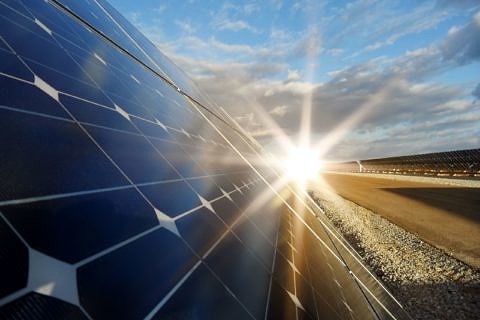Solar cells of the future
Young researcher at FAU develops system for increasing the efficiency of organic solar cells.
Organic solar cells are cheaper to produce and more flexible than their counterparts made of crystalline silicon, but do not offer the same level of efficiency or stability. A group of researchers led by Prof. Christoph Brabec, Director of the Institute of Materials for Electronics and Energy Technology (i-MEET) at the Chair of Materials Science and Engineering at FAU, have been working on improving these properties for several years. During his doctoral thesis, Andrej Classen, who is a young researcher at FAU, demonstrated that efficiency can be increased using luminescent acceptor molecules. His work has now been published in the journal ‘Nature Energy’.
The sun can supply radiation energy of around 1000 watts per square metre on a clear day at European latitudes. Conventional monocrystalline silicon solar cells convert up to a fifth of this energy into electricity, which means they have an efficiency of around 20 percent. Prof. Brabec’s working group has held the world record for efficiency in an organic photovoltaic module of 12.6% since September 2019. The multi-cell module developed at Energie Campus Nürnberg (EnCN) has a surface area of 26 cm². ‘If we can achieve over 20% in the laboratory, we could possibly achieve 15% in practice and become real competition for silicon solar cells,’ says Prof. Brabec.
Flexible application and high energy efficiency during manufacturing
The advantages of organic solar cells are obvious – they are thin and flexible like foil and can be adapted to fit various substrates. The wavelength at which the sunlight is absorbed can be ‘adjusted’ via the macromodules used. An office window coated with organic solar cells that absorbs the red and infrared spectrum would not only screen out thermal radiation, but also generate electricity at the same time. One criterion that is becoming increasingly important in view of climate change is the operation period after which a solar cell generates more energy than was required to manufacture it. This so-called energy payback time is heavily dependent on the technology used and the location of the photovoltaic (PV) system. According to the latest calculations of the Fraunhofer Institute for Solar Energy Systems (ISE), the energy payback time of PV modules made of silicon in Switzerland is around 2.5 to 2.8 years. However, this time is reduced to only a few months for organic solar cells according to Dr. Thomas Heumüller, research associate at Prof. Brabec’s Chair.
Loss of performance for charge separation
Compared with a ‘traditional’ silicon solar cell, its organic equivalent has a definite disadvantage: Sunlight does not immediately produce charge for the flow of current, but rather so-called excitons in which the positive and negative charges are still bound. ‘An acceptor that only attracts the negative charge is required in order to trigger charge separation, which in turn produces free charges with which electricity can be generated,’ explains Dr. Heumüller. A certain driving force is required to separate the charges. This driving force depends on the molecular structure of the polymers used. Since certain molecules from the fullerene class of materials have a high driving force they have been the preferred choice of electron acceptors in organic solar cells up to now. In the meantime, however, scientists have discovered that a high driving force has a detrimental effect on the voltage. This means that the output of the solar cell decreases, in accordance with the formula that applies to direct current – power equals voltage times current.
Andrej Classen wanted to find out how low the driving force has to be to just achieve complete charge separation of the exciton. To do so, he compared combinations of four donor and five acceptor polymers that have already proven their potential for use in organic solar cells. Classen used them to produce 20 solar cells under exactly the same conditions with a driving force of almost zero to 0.6 electronvolts.
Increase in performance with certain molecules
The measurement results provided the proof for a theory already assumed in research – a ‘Boltzmann equilibrium’ between excitons and separated charges, the so-called charge transfer (CT) states. ‘The closer the driving force reaches zero, the more the equilibrium shifts towards the excitons,’ says Dr. Larry Lüer who is a specialist for photophysics in Brabec’s working group. This means that future research should concentrate on preventing the exciton from decaying, which means increasing its excitation ‘lifetime’. Up to now, research has only focused on the operating life of the CT state. Excitons can decay by emitting light (luminescence) or heat. By skilfully modifying the polymers, the scientists were able to reduce the heat production to a minimum, retaining the luminescence as far as possible. ‘The efficiency of solar cells can therefore be increased using highly luminescent acceptor molecules,’ predicts Andrej Classen.
Further information
Doi: https://doi.org/10.1038/s41560-020-00684-7
Andrej Classen
Phone: +49 9131 85 27634
andrej.classen@fau.de
